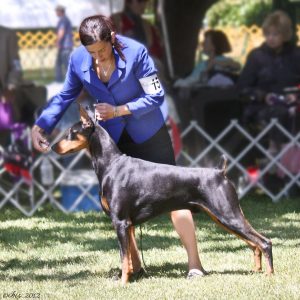The breed originated in Germany in the late 1800s as guard and watch dogs.
Louis Doberman was a tax collector, night watchman, and local dog keeper, who wanted a dog to take on his rounds. He wanted a medium sized (23″-25″ at that time) dog with a short, dark coat (so as not to be seen at night) that was fearless, and “not afraid of the devil himself.”
Ears were cropped and tail docked to make the dogs appear more alert and fearless. There was also “nothing to grab” in the event of a fight. A compact body was desired for more agility. Early dogs were course, long coated, with dense yellow undercoat, and light eyes.
Rottweiler, Manchester Terrier, Beauceron, German Pinscher, Great Dane (blue), Mastiff, Weimaraner, German Shorthaired Pointer and Greyhound were some of the breeds mentioned when “creating” the Doberman Pinscher.
The breed came to the U.S. in 1908, but became more popular after WW II, when soldiers brought dogs back from Germany.
The Doberman Pinscher Club of America (DPCA) was formed in 1921.
Dogs were very tough at first, but over the decades developed a more suitable temperament as family companions. Today they are used as guide dogs for the blind, hearing dogs, in various uses helping the ill, search and rescue, and by law enforcement officials (sniffing out drugs, etc.). Many Dobermans are great hunters and both point and retrieve game. They are easily trained and have a great desire to please. While they are very affectionate and people oriented, they still have the natural instincts they were originally bred for.
See also:
“The Doberman Standard”: The Doberman Pinscher Standard is probably one of the most precise and clearly written standards existing today.
“Francis Frederick Herman Fleitmann – Westphalia Kennels”: The story of one of the breed’s most avid supporters.
“Glenn Scott Staines – Pontchartrain Kennels”: Champion breeder and Doberman advocate.
Download a PDF version of “About the Breed and the Standard”
